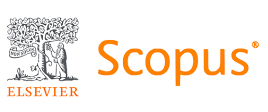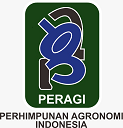The Effects of GA3 Application on the Quality of ‘Kediri Kuning’ Variety of Grape (Vitis vinifera L.)
Abstract
‘Kediri Kuning’ is one of the superior varietiy in Indonesia. Fruit quality is an important thing that must be considered. This research reports the effects of GA3 on the quality of ‘Kediri Kuning’ variety of grape. This experiment employed a randomized block design, five treatments, and seven replications. Meanwhile, the treatments employed GA3 concentrations of 0, 25, 50, 75, and 100 ppm. The GA3 was applied by spraying GA3 in inflorescence twice before anthesis, namely on days 14 and 28 after production pruning. Data was analyzed using analysis of variance and the differences between treatment means were analyzed using Least Significant Difference (LSD). This study revealed that GA3 25-100 ppm could more significantly increase fruit sugar content at harvest, fruit length, and fruit diameter than the control group. Seed weight at a concentration of 100 ppm is lower and more statistically significant than that at other treatments. However, all treatments could not induce seedless because the seed remains in the fruit.
Keywords
Full Text:
PDFReferences
Al-Atrushy, S. M. M. (2016). Effect of GA3 Concentration and Frequency on Yield and Quality of Zark Grape. Jordan Journal of Agricultural Sciences, 12(4), 1183–1191. https://doi.org/10.12816/0035076
Alrashdi, A. M. A., Al-Qurashi, A. D., Awad, M. A., Mohamed, S. A., & Al-rashdi, A. A. (2017). Quality, antioxidant compounds, antioxidant capacity and enzymes activity of ‘El-Bayadi’ table grapes at harvest as affected by preharvest salicylic acid and gibberellic acid spray. Scientia Horticulturae, 220, 243–249. https://doi.org/10.1016/j.scienta.2017.04.005
Astawa, I. N. G., Mayadewi, N. N. A., Sukewijaya, I. M., Pradnyawathi, N. L. M., & Dwiyani, R. (2015). Perbaikan Kualitas Buah Anggur Bali (Vitis Vinifera L.. Var. Alphonso Lavallee) melalui Aplikasi GA3 sebelum Bunga Mekar. Agrotrop : Journal on Agriculture Science, 5(1), 37–42.
Balitjestro. (2012). Prospek Pengembangan Varietas-varietas Unggul Anggur di Daerah Sentra Produksi. http://balitjestro.litbang.pertanian.go.id/prospek-pengembangan-varietas-varietas-unggul-anggur-di-daerah-sentra-produksi
Boğa, A., Binokay, S., & Sertdemir, Y. (2009). The toxicity and teratogenicity of gibberellic acid (GA3) based on the frog embryo teratogenesis assay-Xenopus (FETAX). Turkish Journal of Biology, 33(3), 181–188. https://doi.org/10.3906/biy-0807-30
Casanova, L., Casanova, R., Moret, A., & Agustí, M. (2009). The application of gibberellic acid increases berry size of “Emperatriz” seedless grape. Spanish Journal of Agricultural Research, 7(4), 919–927. https://doi.org/10.5424/sjar/2009074-1105
Cheng, C., Xu, X., Singer, S. D., Li, J., Zhang, H., Gao, M., Wang, L., Song, J., & Wang, X. (2013). Effect of GA3 Treatment on Seed Development and Seed-Related Gene Expression in Grape. PLoS ONE, 8(11), e80044. https://doi.org/10.1371/journal.pone.0080044
Chervin, C., El-Kereamy, A., Roustan, J.-P., Latché, A., Lamon, J., & Bouzayen, M. (2004). Ethylene seems required for the berry development and ripening in grape, a non-climacteric fruit. Plant Science, 167(6), 1301–1305. https://doi.org/10.1016/j.plantsci.2004.06.026
Dimovska, V., Petropulos, V. I., Salamovska, A., & Ilieva, F. (2014). Flame seedless grape variety (vitis vinifera l.) and different concentration of gibberellic acid (GA3). Bulgarian Journal of Agricultural Science, 20(1), 127–132.
El Masri, I., & Sassine, Y. (2018). Effect of gibberellic acid on berry quality of seedless table grapes. IX International Scientific Agriculture Symposium" AGROSYM 2018", 731–736. https://www.researchgate.net/publication/329391265_EFFECT_OF_GIBERELLIC_ACID_ON_BERRY_QUALITY_OF_SEEDLESS_TABLE_GRAPES
Ferdiatik, P. I. (2014). Pengaruh variasi media tanah terhadap pertumbuhan tanaman anggur varietas Kediri Kuning (Belgi) dalam pot. Sanata Dharma University.
Galimba, K. D., Bullock, D. G., Dardick, C., Liu, Z., & Callahan, A. M. (2019). Gibberellic acid induced parthenocarpic ‘Honeycrisp’ apples (Malus domestica) exhibit reduced ovary width and lower acidity. Horticulture Research, 6(1), 41. https://doi.org/10.1038/s41438-019-0124-8
Gao, X., Wu, M., Sun, D., Li, H., Chen, W., Yang, H., Liu, F., Wang, Q., Wang, Y., Wang, J., & He, F. (2020). Effects of gibberellic acid GA3 application before anthesis on rachis elongation and berry quality and aroma and flavour compounds in Vitis vinifera L. ‘Cabernet Franc’ and ‘ Cabernet Sauvignon .’ Journal of the Science of Food and Agriculture, 100(9), 3729–3740. https://doi.org/10.1002/jsfa.10412
Hamman, B., Koning, G., & Lok, K. H. (2003). Homeopathically prepared gibberellic acid and barley seed germination. Homeopathy, 92(3), 140–144. https://doi.org/10.1016/S1475-4916(03)00045-6
Heuvel, K. J. P. T., Barendse, G. W. M., & Wullems, G. J. (2008). Effect of Gibberellic Acid on Cell Division and Cell Elongation in Anthers of the Gibberellin Deficient gib-1 Mutant of Tomato. Plant Biology, 3(2), 124–131. https://doi.org/10.1055/s-2001-12904
Indonesia, K. P. R. (2004). Surat Keputusan Kementerian Pertanian RI Nomor 361/Pkts/LB.240/6/2004 Tanggal 2 Juni 2004 tentang Pelepasan Varietas Kediri Kuning.
Khandaker, M. M., Majrashi, A., & Boyce, A. N. (2015). The influence of gibberellic acid on the chlorophyll fluorescence, protein content and PAL activity of wax apple (Syzygium samarangense var. jambu madu) fruits. Australian Journal of Crop Science, 9(12), 1221–1227.
Liu, H., Huang, C., Tong, P., Yang, X., Cui, M., & Cheng, Z. (2020). Response of axillary bud development in garlic (Allium sativum L.) to seed cloves soaked in gibberellic acid (GA3) solution. Journal of Integrative Agriculture, 19(4), 1044–1054. https://doi.org/10.1016/S2095-3119(20)63156-2
Mohsen, F. S., & Ali, A. A. (2019). Foliar spray of gibberellin (GA3) and urea to improve growth, yield, bunch and berry quality of Red globe grapevine. Current Science International, 8(1), 193–202.
Nampila, R., Chen, B. S., Chen, C. C., & Yang, Y. S. (2010). Effects of GA3 and CPPU on berry size of seedless grapes. Horticulture NCHU, 35(3), 53–64.
Pahi, B., Rout, C. K., & Saxena, D. (2020). Effects of gibberellic acid (GA3) on quality and yield in grapes. International Journal of Chemical Studies, 8(6), 2362–2367. https://doi.org/10.22271/chemi.2020.v8.i6ah.11126
Peacock, B., & Beede, B. (2004). Improving maturity of Thompson seedless for raisin production. Grape Notes–University of California Cooperative Extension, 1(2), 1–4.
Poudel, P., Atreya, P. N., & Dahal, K. C. (2022). Effect of Gibberellic Acid (GA3) on Yield and Fruit Quality of Table Grape var. Himrod in Kathmandu Valley, Nepal. Journal of Agriculture and Environment, 23(1), 131–142. https://doi.org/10.3126/aej.v23i1.46922
Varoquaux, F., Blanvillain, R., Delseny, M., & Gallois, P. (2000). Less is better: new approaches for seedless fruit production. Trends in Biotechnology, 18(6), 233–242. https://doi.org/10.1016/S0167-7799(00)01448-7
Vyver, L. van der. (2016). The influence of gibberellic acid (GA₃) for berry thinning and berry sizing on table grape production, quality and fertility of Prime (Issue December). Stellenbosch University.
Xu, Y., Hou, X., Feng, J., Khalil-Ur-Rehman, M., & Tao, J. (2019). Transcriptome sequencing analyses reveals mechanisms of eliminated russet by applying GA3 and CPPU on ‘Shine Muscat’ grape. Scientia Horticulturae, 250, 94–103. https://doi.org/10.1016/j.scienta.2019.02.048
Zang, Y.-X., Chun, I.-J., Zhang, L.-L., Hong, S.-B., Zheng, W.-W., & Xu, K. (2016). Effect of gibberellic acid application on plant growth attributes, return bloom, and fruit quality of rabbiteye blueberry. Scientia Horticulturae, 200, 13–18. https://doi.org/10.1016/j.scienta.2015.12.057
Refbacks
- There are currently no refbacks.



























